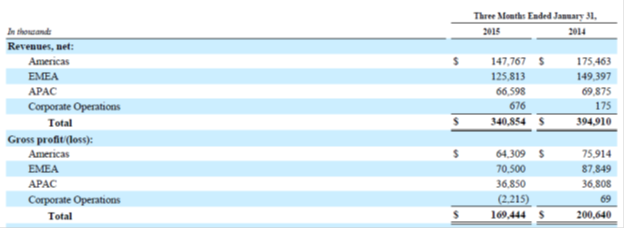SPY’s March 31 Quarter; Curious About the Inventory
I have admired SPY for the organizational, strategic positioning, and expense control changes they’ve implemented in the last couple of years. But there’s a limit to how far you can reduce expenses. After that, SPY has to find ways to increase sales or its gross margin to find a way out from under its $21.5 million in shareholder debt.
That number, by the way, is actually down a few thousand from the end of last year’s quarter. Good to see it no longer increasing.
Sales revenue was more or less constant, declining from $9.192 million in last year’s quarter to $9.131 million this year. The decline was “…principally attributable to lower sales of our sunglasses which decreased by 6.2% or $0.5 million during the three months ended March 31, 2015…The decrease was partially offset by an increase in sales of our goggle and prescription frame product lines, which increased by 44.1% and 9.4%, respectively or $0.4 million and $0.1 million, respectively, during the three months ended March 31, 2015…” Sunglasses are a tough market.
Sunglasses were 74.9% of total revenue, down from 79.4% in last year’s quarter. North American revenue was 86.5% of total revenue. Sales also included about $600,000 in closeouts, up from $400,000 in last year’s quarter.
The gross profit margin rose from 52.0% to 54.8%. That’s quite jump. It was the result of “…(i) increased efficiencies in product development and manufacturing that reduced the cost of our products; (ii) reduced air freight-in charges for new products.” Remember they’ve moved a lot of their sunglass production from Italy to China.
Sales and marketing expenses rose from $2.9 to $3.2 million “…primarily due to increases in marketing events, tradeshows and promotions.” I’m glad to see that increase. It sounds like they are spending it on the right things.
Income from operations improved from $84,000 to $193,000. Interest expense was down from $757,000 to $488,000 but remember the shareholder who owns most of the debt cut the interest rate last year and that largely explains the decline. The net loss declined from $742,000 to $409,000.
I do have a question or two about the balance sheet and cash flow. Cash provided by operations was $2.1 million ($2.28 million in last year’s quarter). Looking at the balance sheets for December 31, 2014 and March 31, 2015, we see a decline in receivables from $7.17 to $5.39 million. Inventory fell 13.1% from $7.7 to $6.69 million. They note in the 10-Q that, “During the three months ended March 31, 2015, the Company had positive cash flow from operations principally due to timing of inventory purchases and higher collections on accounts receivable.”
Last year, they said they had positive cash flow “…principally as a result of a significant reduction in operating expenses and increases in gross profit.”
So last year it was because they operated better. This year, as I read what they say, it was due to what sound like timing differences. People paid earlier than expected and inventory that was set to arrive didn’t. Cash flow from improved operations is lasting. Cash flows from timing differences reverse themselves in subsequent quarters.
Complicating this is that last year’s sales for the quarter were about the same as this year. But last year’s quarter ended with inventory of $4.34 million, where inventory this year was $6.69 million.
Their wording confuses me. Do they mean they would have had much lower or even negative cash flow if it wasn’t for the timing of inventory purchases and higher receivables collections?
Second, if the timing of inventory purchases helped cash flow that means to me that they didn’t have to pay for some inventory they thought they were going to have to pay for during that quarter. But their inventory at March 31, 2015 is already 54% higher than a year ago. And I guess that the inventory that they didn’t get in the first quarter will show up in the second. What are they going to do with it all?
My hope is that the explanation involves new orders and increasing sales. Maybe we’ll get better insight next quarter.






